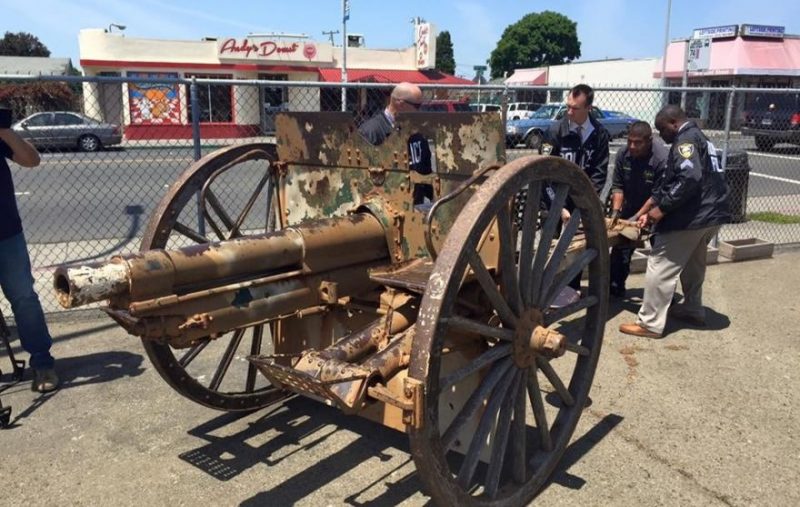It was outside of the Veterans Memorial Hall in Richmond California during the early morning of May 1st. Thieves were on the run after stealing a World War I era cannon located just outside of the memorial. The iconic artillery antique had been there for seven decades, but now it was being sold to an unsuspecting buyer.
It was a bold escapade, but sadly it was not an uncommon occurrence. Thieves have been pillaging and robbing VFW halls, museums, and even graves in order to obtain viable American war memorabilia for the black market that operates online, in flea markets, and through a shady network of avid collectors. According to law enforcement and dealers assigned to figure out the identity of stolen items, some of this memorabilia is worth thousands of dollars.
A New York retired Army National Guard officer named Pat Chaisson is a history buff and experienced collector of military and war memorabilia. He recognizes that there is undoubtedly a market for these types of things. Chaisson said:
“The buyer has to be very careful. All of the collectors I know are very sensitive that there’s a black market out there – that what you’re buying could very well have been stolen. And it’s difficult to identify sometimes. How do you prove that a musket ball or cannon wasn’t stolen from an armory or a collection?”
The iron and brass cannon stolen from the Veterans Memorial Hall in Richmond was a five feet high. The buyer paid $1,200 for it, but contacted the police to return it once he saw a news story about it. Richmond Police Department released a statement that said, “This act is about stealing a piece of our country’s history, and stealing from our war veterans who fought bravely for our country and our freedom. This gentleman was more than helpful and felt absolutely horrible he had inadvertently bought a stolen piece of American history.”
Unfortunately, this story about the cannon is just one of many taking place around the country. Experts continue to confirm the priceless military and war memorabilia being taken – from tanks in front of small-town VFW halls to medals displayed in unguarded government buildings. Clearly the avid collectors and unethical middlemen are not too concerned about where the items are coming from or how they are being obtained.
Rick Brumby is a historian at the Museum of Military History in Kissimmee, Fla. He says there is no way to track this stuff because they lack serial numbers. Furthermore, he knows there is a market for items like this, but most of the time they are not sold on reputable auction sites such as eBay. He said, “The real stuff has a tendency to go into private collections. People get greedy and, if the price is right, they’ll buy it and keep it in their home.” It is often times after they pass away that the truth comes out.
Currently, the Vermont State Police are working to track down Civil War memorabilia that was stolen back in October from a Shrewsbury man’s home. These items had literally been passed on through multiple generations. The George Lincoln home had valuables taken that included a 6” flintlock pistol with a small leather powder horn, a post-Civil War-era bayonet, and a distinctive Civil War Union soldier’s leather ammo case.
This theft came after another Vermont case back in 2015. These thieves stole from the family related to a nurse who served in the United States Army; it was memorabilia she had kept from World War II. A Detective Sgt. From the Vermont State Police confirmed how hard it is to relocated stolen items of this nature. Benjamin Katz feels the dealers and the second hand buyers are the drivers of these types of crime. He said, “Not all dealers are shady, of course, but all it takes is a couple. In Vermont, if they know it’s stolen, they have to call police. But it’s impossible for us to prove they knew it was stolen. It’s basically an honor code. There’s very little regulation when it comes to the purchase of antiquities.”
Investigators from the Sacramento County, California Sheriff’s Department came across a “trove” of military medals and memorabilia. This discovery took place during a probation search in February, 2015. The items were originally reported stolen in 2014. They were the property of a family of an Air Force pilot who served his country during World War II. Items that went missing included a Purple Heart medal, photographs, and the man’s personal diary. He had written in the diary while he was a prisoner of war. Fortunately, the police were able to return the collection of priceless goods back to the pilot’s family, whose members were living in a different state at the time.
Another horrendous example of war collectible theft involved the desecrating and looting of fallen soldiers’ graves. Law enforcement came across this in Burke County, Georgia in 2013. Two men had allegedly raided the graves of five Confederate soldiers that had been buried inside the Old Church cemetery. It appears the thieves had been looking for heirlooms.
According to antique brokers these historic war relics are valued at a high price. For example, an officer’s sword from the Civil War can go for between $20,000 and $30,000. Uniforms and medals range from $500 to upwards of thousands of dollars. In 2011, Abraham Lincoln’s burial site in Springfield, Illinois was targeted by thieves. They took a 3-foot long sword from a statue on the tomb. Due to budget cuts, the guard that had watched the tomb overnight had been eliminated.
